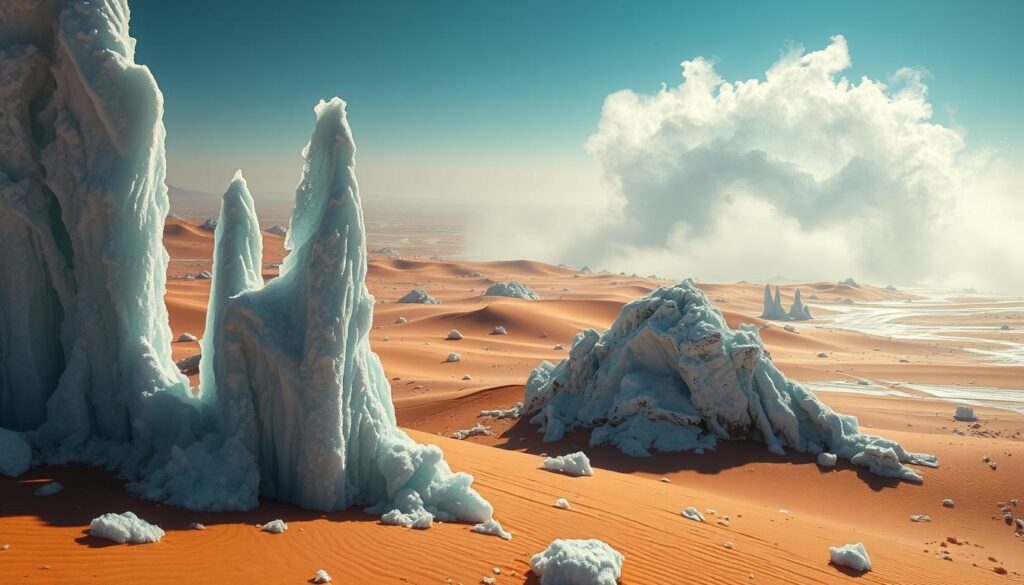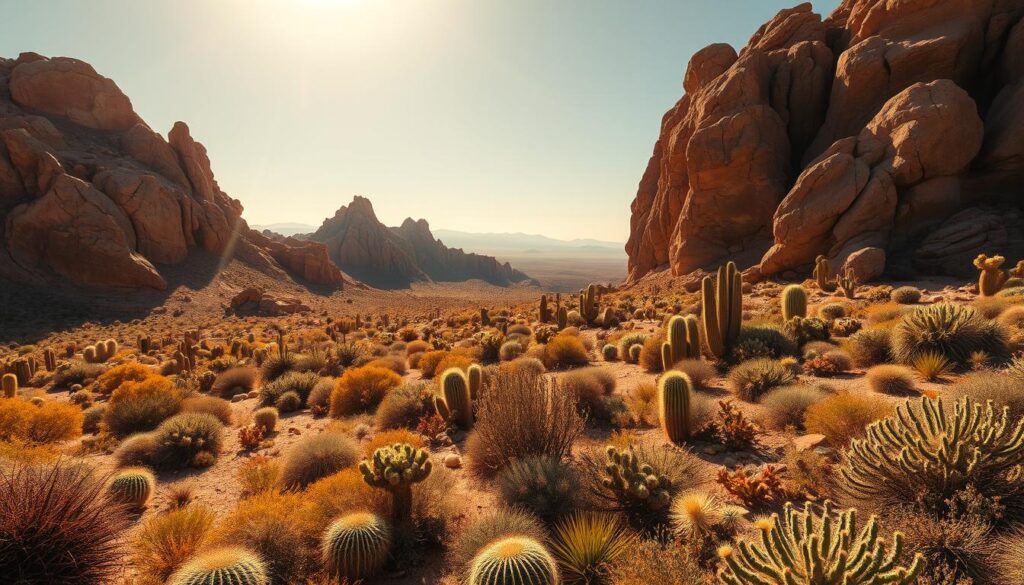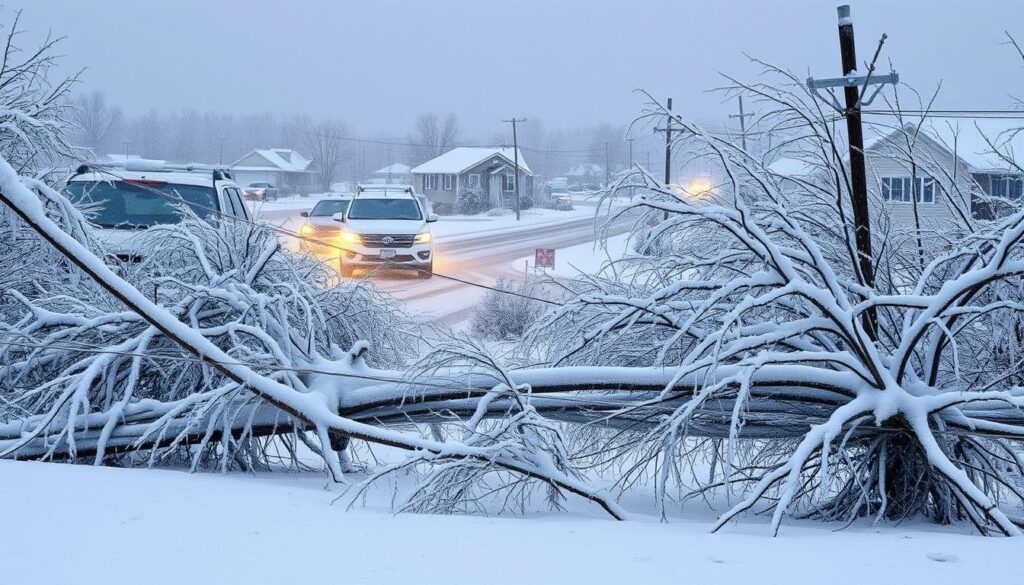A sudden ice storm in the desert is a rare event that has amazed many. It’s not just unexpected but also fascinating, drawing lots of interest. The desert, known for its hot and dry weather, is not where you’d expect ice storms.

This ice storm in the desert has shocked everyone and made people curious about why it happened. It’s a rare event that scientists are eager to study. They want to learn more about the weather conditions that caused it.
People are also wondering how this sudden change in weather will affect the desert’s plants and animals. It’s a big concern for the local ecosystem.
Key Takeaways
- A sudden ice storm in the desert is a rare and unexpected weather phenomenon
- The event has sparked widespread interest and curiosity among scientists and residents alike
- The desert’s hot and dry climate makes it an unlikely place for ice storms to occur
- The sudden ice storm has raised questions about the meteorological factors that led to its occurrence
- The event provides a unique opportunity for scientists to study and understand the underlying causes of such phenomena
- The impact of the ice storm on the local ecosystem is a topic of interest and concern
The Extraordinary Moment: Sudden Ice Storm in the Desert Unfolds
The desert is known for its scorching heat. But on this day, a sudden ice storm hit, creating a memorable weather event. The quick change in weather surprised everyone, with temperatures dropping and icy winds blowing.
As the storm started, the first signs were clear. The sky turned dark grey, and the air got colder fast. The ice storm’s growth was fast and strong, with freezing rain and hail hitting the ground. People were shocked and amazed, trying to understand the storm’s size.
Key Factors of the Storm’s Development
- Rapid temperature drop
- Freezing rain and hail
- Strong icy winds
The storm was a perfect mix of these factors, thanks to the desert climate. This rare event would deeply affect the desert’s ecosystem. As the storm went on, people’s shock turned to worry. They wondered how the ice storm would change the desert’s climate for good.
Understanding Desert Climate and Why Ice Storms Are Rare
The desert is known for its extreme heat and dryness. It’s one of the most challenging places on Earth. Yet, sometimes, rare weather events like ice storms can happen. To understand why ice storms are rare, we need to look at the desert’s typical weather.
The desert has low humidity, lots of sunlight, and little rain. These conditions make it hard for ice storms to form. Atmospheric conditions like temperature, humidity, and wind are key. They shape the desert and make it sensitive to small weather changes.
- Limited precipitation: Deserts get very little rain, making ice storms unlikely.
- High temperatures: The desert’s heat makes it hard for temperatures to drop enough for ice.
- Low humidity: The desert’s dry air stops the moist conditions needed for ice storms.
By understanding the desert and its weather, we see how rare ice storms are. The desert’s weather and conditions make it a fascinating place to study.
Meteorological Factors Behind This Unique Weather Event
The sudden ice storm in the desert was a rare and fascinating phenomenon. Understanding the meteorological factors behind it is key. Atmospheric conditions were crucial, with temperature changes and rain patterns playing a big role. The movement of high and low-pressure systems also affected the storm’s path and strength.
Global weather patterns also played a part in the storm. The mix of different air masses and weather systems made it unique.
Some key meteorological factors that helped create the storm include:
- Temperature fluctuations: The big drop in temperature allowed ice and snow to form.
- Precipitation patterns: The heavy rain led to ice and snow buildup.
- Global weather patterns: The mix of air masses and weather systems made the storm special.
By studying these atmospheric conditions and global weather patterns, scientists can learn more about the meteorological factors behind this rare event. They can also understand how these factors might affect future weather.
Impact on Local Desert Ecosystem
The sudden ice storm has hit the local desert ecosystem hard. It has raised big worries about how it will affect plants and animals. The desert ecosystem is very sensitive to extreme weather, and this storm has brought new challenges. The changing climate makes it hard for plants and animals to adjust, and this storm has made things worse.
The ice storm has had many effects on the desert ecosystem. For example:
- Damage to plant life: The ice and cold have hurt or killed many plants, which could harm the ecosystem for a long time.
- Disruption of food chains: The storm has messed up the food chains, making it hard for animals to find food and survive.
- Changes in soil composition: The ice and cold have changed the soil, which could affect plant growth in the future.

The ice storm shows how crucial it is to understand and tackle climate unpredictability. The desert ecosystem is delicate and needs protection from extreme weather. By studying the storm’s effects, scientists can learn a lot about climate change. They can also work on ways to lessen its impact on the desert ecosystem.
Documentation and Scientific Observations
The sudden ice storm in the desert has been well-documented. Scientists used weather stations, satellite images, and expert opinions. These tools gave us a good look at the storm’s effects on the environment.
Weather stations helped scientists track the storm’s temperature, rain, and wind. This data is key to understanding the storm and predicting future ones. Satellite images showed the storm’s path and size, helping us see its impact on the desert.
Experts from places like the National Oceanic and Atmospheric Administration (NOAA) also shared their insights. Their knowledge helped us understand the storm’s importance and its link to climate change. Their input was crucial for the scientific community.
- Unprecedented low temperatures, with some areas reaching record lows
- Significant precipitation, resulting in flash flooding and soil erosion
- Strong winds, causing damage to infrastructure and vegetation
These findings show why we need to keep studying extreme weather like this desert ice storm. By looking at weather data, satellite images, and expert opinions, scientists can learn more. This knowledge helps us understand these events and their effects on our environment and communities.
Effects on Local Communities and Infrastructure
The ice storm hit local communities hard, changing daily life and essential services. People struggled to get food, water, and healthcare because of the storm’s impact on infrastructure.
The storm also hurt the local economy. Many businesses had to close, causing financial losses for owners and workers. Emergency services were under a lot of pressure, with responders working hard to help those in need.
Some of the main effects on local communities and infrastructure include:
- Transportation services were disrupted, making it hard for people to get to work or school.
- Power outages affected communication and access to important services.
- Buildings and homes were damaged, forcing some residents to leave their homes.

Local authorities and communities came together to help those affected by the storm. The storm showed how crucial strong infrastructure and emergency plans are. They help protect local communities from extreme weather events.
Environmental Scientists’ Perspectives on the Phenomenon
Environmental scientists are trying to figure out the sudden ice storm in the desert. They think it might be linked to climate change. They are looking into how extreme weather and climate change affect our environment. Their aim is to create future prediction models for such events.
Environmental scientists say studying data and trends is key. By analyzing this, they find patterns and connections. This helps them make better future prediction models.
- Temperature and precipitation patterns
- Atmospheric conditions and global weather patterns
- The impact of climate change on ecosystems and wildlife
By understanding these, scientists can make more accurate future prediction models. This helps communities get ready for extreme weather, reducing damage and harm.
Desert Wildlife Response to Icy Conditions
The desert recently faced an ice storm, bringing new challenges to its wildlife. Native species are struggling to cope with the cold. Scientists are watching closely to see how these animals will adapt.
Desert animals face many hurdles, like finding less food and changing their homes. Some might move to warmer places or eat different things. The cold also makes it hard for them to find safe places, leading to more deaths.
Researchers have seen desert animals change their ways to survive. They might move differently or sleep in new places. These changes help them live through the cold. Scientists are studying these changes to learn more about desert animals and how they might face future climate changes.
Some key ways animals adapt include:
- Changes in foraging strategies
- Altered social behaviors
- Modified breeding habits
These changes are crucial for desert animals to survive. More research is needed to fully understand how animals and the desert ecosystem interact in cold weather.
Photography and Media Coverage of the Event
The sudden ice storm in the desert has caught the eye of many. It’s a rare sight of ice in a desert setting. This has made it a perfect spot for photography lovers to take amazing pictures. Both pros and hobbyists have shared their photos and stories on social media.
Many news teams have rushed to the desert to cover the storm. They face big challenges in reporting on this event. But, it’s crucial to report accurately and responsibly. The ice storm shows how vital media is in sharing news of unusual weather.
Some key parts of the media coverage include:
- Live updates and reports from the scene
- Interviews with experts and locals affected by the storm
- Stunning photography and videography of the event
The media coverage of the ice storm has given the public important info. It has also made people more aware of the effects of rare weather on communities and nature. As extreme weather becomes more common, the need for accurate media coverage will keep growing.
Conclusion: What This Rare Weather Event Teaches Us About Climate Unpredictability
The sudden ice storm in the desert is a clear sign of our changing climate’s unpredictability. It shows how crucial ongoing research and global teamwork are. We need to keep studying and working together to tackle climate challenges.
This rare event teaches us to stay alert and flexible. By studying the storm, we learn more about global weather patterns. This knowledge helps us understand how these patterns affect our local environments.
This event also shows we need better emergency plans and stronger communities. Scientists, policymakers, and local groups must work together. Together, we can reduce risks and make the most of these unexpected weather events.
FAQ
What caused the sudden ice storm in the desert?
A rare mix of weather conditions caused the sudden ice storm in the desert. This included unusual air movements, temperature changes, and global weather patterns. Experts say the storm happened when high and low-pressure systems met, causing quick cooling and ice formation.
How did the ice storm impact the local desert ecosystem?
The ice storm hit the desert ecosystem hard. It covered the area in ice and snow, messing up the life cycles of plants and animals. Many species found it hard to adjust, raising concerns about the ecosystem’s future.
What kind of documentation and scientific observations were made during the ice storm?
Scientists and meteorologists watched the storm closely. They used weather stations, satellite images, and field reports to gather data. This information helped them understand the storm’s development and the weather conditions that caused it.
How did the local communities and infrastructure respond to the ice storm?
The ice storm was a big challenge for local communities and infrastructure. Roads were blocked, power went out, and services were disrupted. Emergency teams worked hard to clear roads, fix power, and help people. The community showed great resilience and came together to face the storm.
What do environmental scientists say about the potential connection between the ice storm and climate change?
Environmental scientists are looking into the link between the ice storm and climate change. They think climate change might make such storms more common. More research is needed to see if this storm is part of a bigger climate trend.
How did the desert wildlife respond to the icy conditions?
Desert wildlife had a tough time with the ice. Animals like tortoises and jackrabbits found it hard to find food and shelter. Researchers saw them huddle together for warmth and change their eating habits. Studying how wildlife adapts is key to understanding future climate challenges.
Where can I find the best photographs and media coverage of the ice storm event?
The ice storm in the desert drew a lot of attention from photographers. Amazing photos and videos are all over social media and news. For the best coverage, check out the dedicated website or social media channels for this event.
